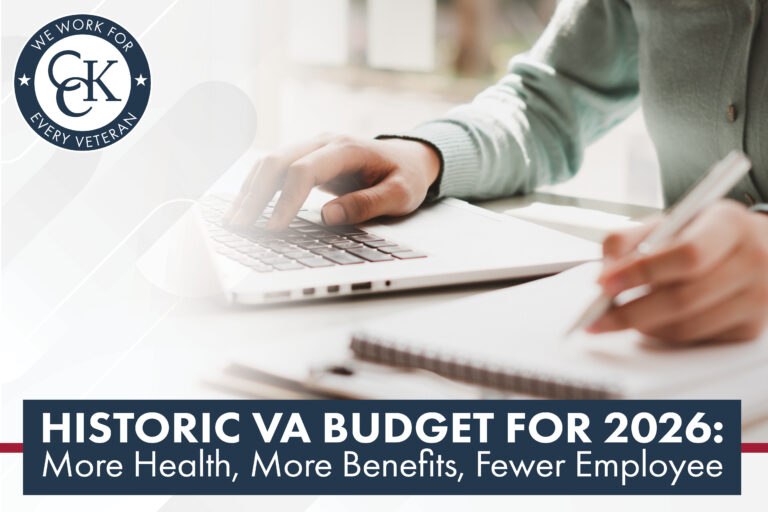Historic VA Budget for 2026: More Healthcare, More Benefits, Fewer Employees

CCK Law: Our Vital Role in Veterans Law
The Department of Veterans Affairs’ (VA) budget proposal for fiscal year 2026 has captured attention not only for its size—$441.2 billion, the highest in the agency’s history—but also for the internal tensions it raises: more funds, more programs, and fewer employees to carry them out.
In a recent segment of the Veterans Legal Lowdown podcast, attorneys Emma Peterson and Maura Black, partners at CCK Law, analyzed in depth the content and implications of the proposed VA budget for 2026, which is still awaiting final approval in Congress.

A 10% Increase: Where Is the Money Going?
One of the main areas of focus in the proposal is health care. The budget allocates approximately $165.1 billion for health, a 17% increase over the prior year. Expansion of the Community Care program accounts for a more than 50% increase, with priority given to mental health and suicide prevention.
“VA is a massive agency, really made up of three agencies in one: the Veterans Health Administration (VHA), the Veterans Benefits Administration (VBA), and the national cemetery system,” Peterson said. “That’s why this budget reflects such a colossal operation.”
The PACT Act, passed in 2022, expanded access to benefits for veterans exposed to toxic substances during service. This has generated a sharp rise in claims for health conditions now considered presumptive, forcing VA to allocate significantly more resources to both health care and disability payments.
“We’re seeing that the impact of the PACT Act keeps growing,” Black said. “The surge in claims for benefits and health care related to toxic exposures has required a stronger response from VA.”
The 2026 budget represents a 10% increase compared to the previous year. Its main priorities include:
- $165.1 billion for health care, up 17%.
- More than a 50% increase for community care, which allows veterans to receive care outside VA facilities.
- Strong investment in mental health, suicide prevention, and PACT Act follow-up.
- $31.2 billion in mandatory benefits, including disability compensation, education, and loans.
- $3.4 billion to combat veteran homelessness.
- $2.17 billion to restart the troubled electronic health records system.
The Dilemma: Fewer Hands, More Work
Although the VA budget for 2026 is larger, VA also anticipates reducing staff by up to 30,000 employees, sparking concerns about the system’s operational capacity.
“It doesn’t make sense to cut staff when there are more claims, more health care needs, more programs underway,” said Peterson.
VA has stated that the reductions would occur through attrition, retirements, and unfilled vacancies, but even with that approach, veteran advocates have wondered whether efficiency and quality of service can be maintained. The size of the VA budget for 2026 doesn’t guarantee impact unless paired with effective implementation strategies.
“Success depends on whether VA has the staffing, the processes, and the political will to put these funds into action,” said Peterson.
Housing: The Human Face of the Budget
The budget also places special emphasis on housing and social support initiatives. The $3.4 billion allocation aims to reduce veteran homelessness through subsidy programs, eviction prevention, and direct assistance.
“We’re talking about a human investment,” said Black. “This isn’t just numbers, it’s lives.”
What’s Next?
The 2026 VA budget proposal still awaits a final vote. The Senate and House of Representatives have presented different versions, with contrasting emphases on social amendments and budgetary restrictions.
Are You a Veteran and Have Questions About How this Proposed Budget Affects You?
Watch the full Veterans Legal Lowdown episode here. Visit our blog for other articles about veterans law, including detailed guides about community care, the PACT Act, and how to file a claim.
If you need help with your VA disability appeal, reach out to us anytime to discuss your case, either online or by calling (800) 544-9144.
About the Author
Share this Post
